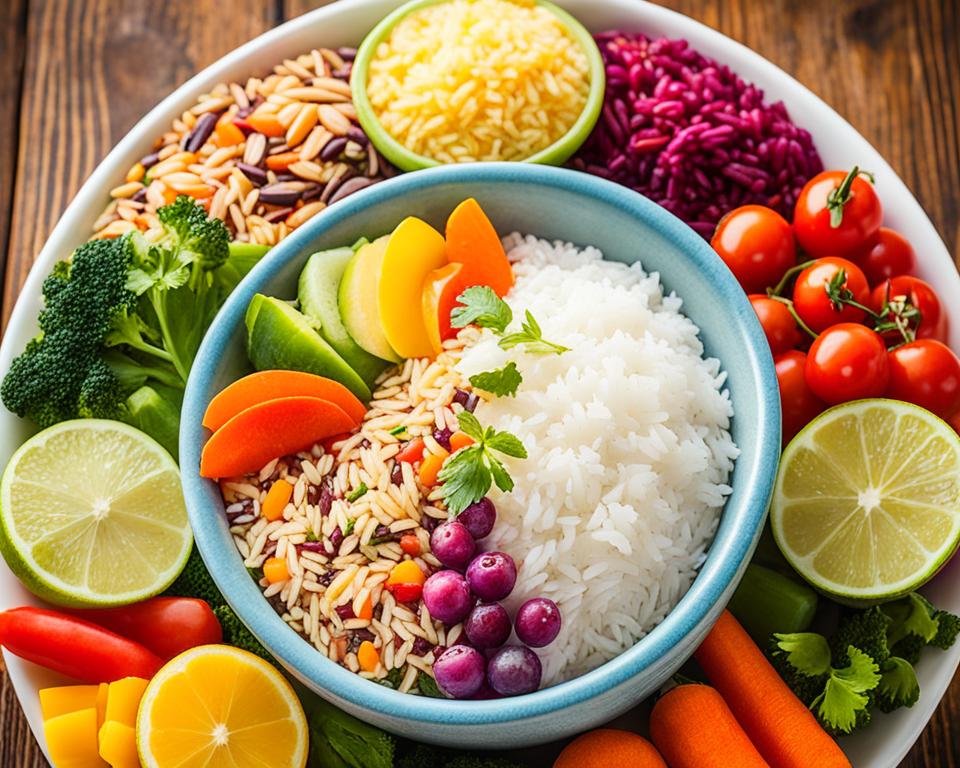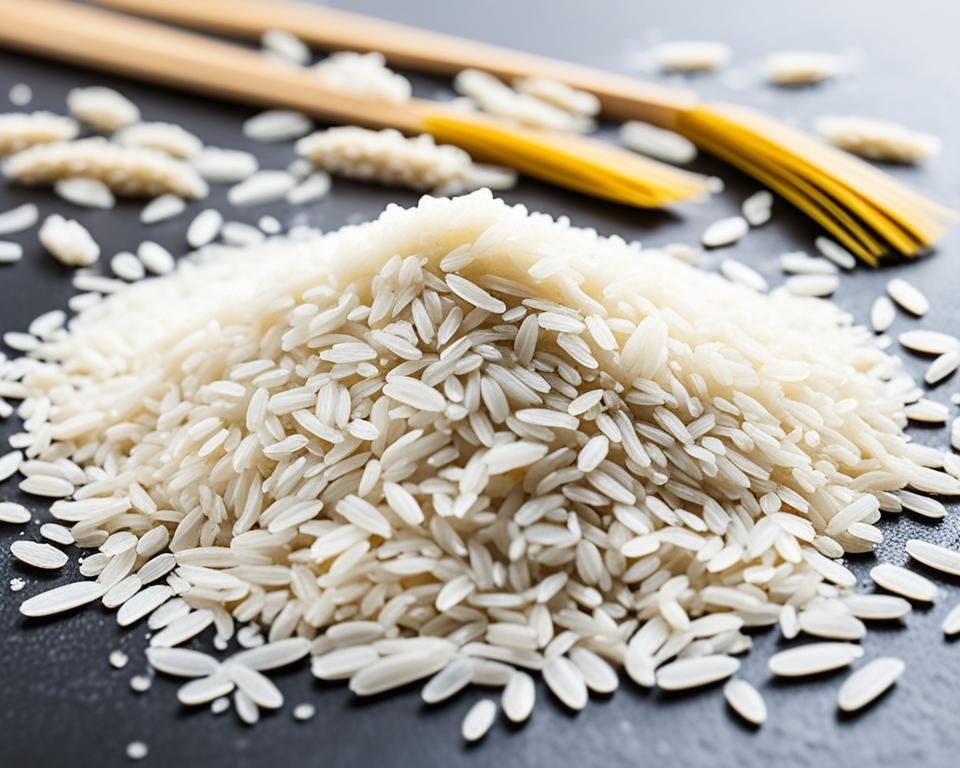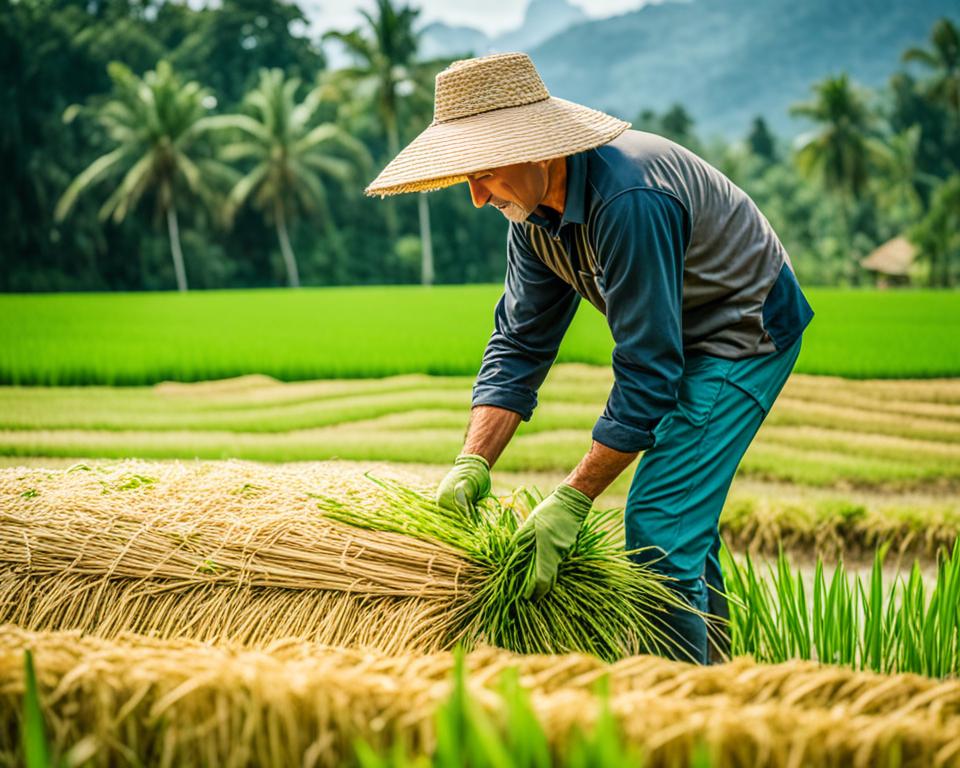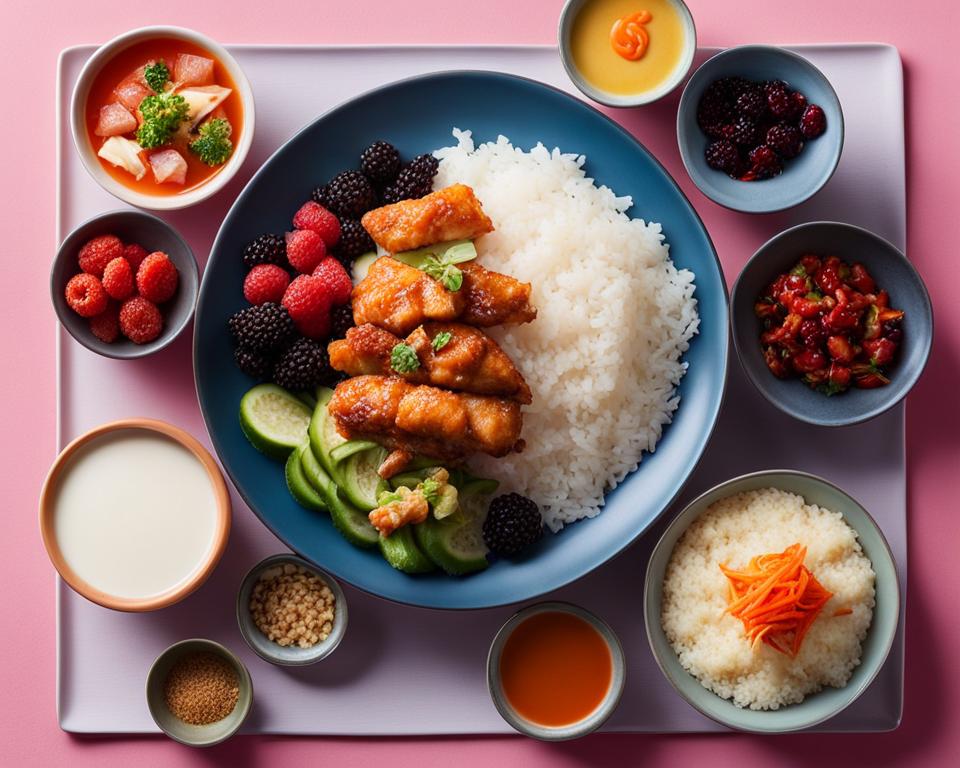In this article, we will explore the various uses of rice beyond just being a staple food. Rice is an incredibly versatile ingredient that goes beyond the dining table, offering diverse applications in cooking, health, beauty, traditional medicine, household remedies, crafts, and more. Let’s dive into the world of rice and discover its remarkable versatility.
Key Takeaways:
- Rice has numerous uses beyond being a staple food.
- Rice can be utilized in cooking, health and beauty regimes, traditional medicine, household remedies, crafts, and more.
- Exploring the diverse uses of rice can open up new possibilities and creative applications.
- Rice holds cultural significance and symbolizes fertility, prosperity, and happiness in many societies.
- Embrace the versatility of rice and incorporate it into various aspects of your life.
Rice in Cooking

Rice is not just a side dish; it forms the foundation of numerous culinary creations. Whether you’re a seasoned chef or a cooking enthusiast, there’s a world of delicious possibilities when it comes to rice recipes. From fluffy basmati to sticky sushi rice, each variety brings its unique texture and flavor to the table.
To truly appreciate the versatility of rice, explore different cuisines and their signature rice dishes. From comforting risottos to fragrant biryanis, you can create a culinary journey in your own kitchen. Rice also shines as a side dish, complementing a wide range of main courses, from grilled meats to flavorful curries.
Whether you’re cooking a hearty meal for your family or hosting a dinner party, rice dishes are a crowd-pleaser.
Exploring Rice Recipes
To get started with cooking rice, it’s essential to understand the various types and their ideal cooking methods. Different types of rice require different water-to-rice ratios and cooking times. Here are some popular rice varieties and their recommended cooking techniques:
- Basmati rice: Known for its aromatic nature, basmati rice pairs well with Indian and Middle Eastern flavors. It is best cooked using the absorption method, where the rice absorbs the exact amount of water needed.
- Arborio rice: This short-grain rice is the star of creamy risottos. Its high starch content creates a luscious texture when slowly cooked with broth, wine, and other flavorful ingredients.
- Jasmine rice: Popular in Southeast Asian cuisine, jasmine rice has a delicate fragrance that complements spicy dishes. It is typically cooked using the absorption method.
- Sushi rice: This short-grain rice is a staple in Japanese cuisine and forms the base of sushi rolls. It requires precise cooking and seasoning to achieve the perfect sticky texture.
Once you master the cooking techniques, you can let your creativity soar with a myriad of rice recipes. Spice up your weeknight dinners with a flavorful chicken and vegetable stir-fry over steamed jasmine rice. Impress your guests with a colorful paella, showcasing the rich flavors of saffron-infused rice, fresh seafood, and Spanish spices. Or indulge in the comforting embrace of a creamy mushroom risotto, perfectly paired with a glass of wine.
Rice recipes offer endless possibilities to experiment with flavors and textures, making it a delightful ingredient for culinary adventures.
Whether you’re a fan of spicy curries, hearty stir-fries, or comforting casseroles, rice is a versatile companion that enhances the flavors and textures of any dish. Its ability to absorb flavors and provide a satisfying base makes it an indispensable ingredient in cuisines around the world.
Next, let’s delve into the health benefits of rice and discover how this humble grain contributes to a balanced diet.
Rice in Health Benefits

Rice is not only a delicious and versatile ingredient, but it also offers numerous health benefits that contribute to overall well-being. Packed with essential nutrients and a valuable source of energy, rice is a key player in maintaining a balanced diet.
When it comes to nutritional value, rice stands out for its impressive composition. It is a good source of carbohydrates, providing the body with the energy it needs for daily activities. Additionally, rice contains essential amino acids, vitamins, and minerals that are necessary for various bodily functions.
One of the primary health benefits of rice is its ability to support a balanced diet. As a low-fat and low-cholesterol food, rice can be an excellent choice for those looking to maintain a healthy weight or manage certain health conditions. It is also gluten-free, making it suitable for individuals with gluten sensitivity or celiac disease.
The nutritional value of rice extends beyond its macronutrient content. It is rich in minerals such as manganese, magnesium, and selenium, which play vital roles in promoting proper cellular function, supporting bone health, and boosting the immune system.
Rice is also an excellent source of B vitamins, including thiamin, niacin, and vitamin B6. These vitamins contribute to the metabolism of carbohydrates, proteins, and fats, helping the body convert food into energy. They also play a crucial role in maintaining healthy nerve function and promoting red blood cell production.
Rice for a Balanced Diet
Adding rice to your diet can help ensure a well-rounded and balanced meal plan. Its high complex carbohydrate content provides a sustained release of energy, making it an ideal choice for fueling the body throughout the day. Rice is also easily digestible, making it gentle on the stomach and suitable for individuals with sensitive digestive systems.
Not only does rice provide a filling and satiating component to meals, but it also pairs well with a variety of proteins, vegetables, and flavors, allowing for endless combinations and culinary creativity. Whether it’s a hearty stir-fry, a comforting bowl of risotto, or a nutritious rice salad, incorporating rice into your meals can help create a balanced and satisfying dining experience.
The health benefits of rice go beyond mere nutritional value. Research has shown that regularly consuming rice as part of a balanced diet can have positive effects on overall health, including reduced risk of chronic diseases such as heart disease and certain types of cancer. Additionally, the high fiber content in rice can aid in digestion, promote bowel regularity, and support a healthy gut.
“Rice is a nutritious and versatile grain that can be a valuable addition to a well-rounded diet.” – Dr. Emily Smith, Registered Dietitian
Incorporating rice into your meals not only provides essential nutrients but also allows for a diverse and enjoyable dining experience. Its versatility as a base ingredient or side dish makes it a staple in cuisines around the world.
Next, we’ll dive into the various ways rice can be incorporated into beauty regimes, unlocking its potential for enhancing hair and skincare.
Rice in Beauty Regimes

Incorporating rice into your beauty routine can have remarkable effects on your hair and skin. Rice water, rice face masks, and other skincare practices involving rice have gained popularity for their natural and nourishing properties.
The Benefits of Rice Water for Hair
Rice water, the leftover water from rinsing rice, has been used for centuries as a natural hair treatment. Packed with vitamins, minerals, and amino acids, rice water helps to strengthen and nourish hair follicles, promoting healthy hair growth and adding shine to dull strands.
“Rice water has been a game-changer for my hair. It has made my locks stronger, smoother, and more resistant to breakage.” – Sarah, beauty enthusiast
You can easily incorporate rice water into your hair care routine by using it as a final rinse after shampooing and conditioning. Simply collect the water produced from rinsing rice, let it sit for 24 hours to ferment, and then apply it to your hair. Massage the rice water into your scalp and hair, leave it on for a few minutes, and rinse thoroughly.
DIY Rice Face Masks for Glowing Skin

Rice face masks are a popular skincare remedy known for their ability to promote a healthy and radiant complexion. Rice contains antioxidants that can help reduce inflammation, brighten skin tone, and minimize the appearance of fine lines and wrinkles.
- Rice Flour Face Mask: Mix 2 tablespoons of rice flour with enough water or rosewater to form a paste. Apply the paste to your face and neck, leave it on for 15-20 minutes, and then rinse off with warm water. This mask helps exfoliate dead skin cells and can leave your skin feeling smooth and rejuvenated.
- Rice and Honey Face Mask: Combine 1 tablespoon of cooked rice with 1 teaspoon of honey. Mash the rice and honey together to form a thick paste. Gently massage the mixture onto your face, focusing on areas of concern. Leave the mask on for 15 minutes before rinsing off with lukewarm water. This mask can help hydrate and nourish your skin, leaving it soft and supple.
Other Skincare Practices Involving Rice
Rice possesses natural properties that make it beneficial for various skincare practices. Here are a few additional ways you can incorporate rice into your beauty routine:
- Rice Water Toner: After washing your face, apply rice water using a cotton pad as a natural toner. It helps to tighten pores, balance oil production, and maintain skin’s pH balance.
- Rice Bran Scrub: Mix rice bran with a little water or yogurt to create a gentle scrub. Gently massage the mixture onto your face in circular motions to exfoliate and remove dead skin cells.
By embracing rice in your beauty regimen, you can experience the natural benefits it offers for your hair and skin. Whether you incorporate rice water into your hair care routine or indulge in a DIY rice face mask, these beauty practices will help you achieve a healthy and glowing complexion.
| Rice Beauty Regime | Benefits |
|---|---|
| Rice Water for Hair | Strengthens hair, promotes growth, adds shine |
| Rice Face Masks | Reduces inflammation, brightens skin tone, minimizes fine lines |
| Other Skincare Practices | Tones skin, exfoliates, balances oil production |
Rice in Traditional Medicine

In traditional medicine systems spanning cultures worldwide, rice has held a significant place for centuries. Beyond its role as a staple food, rice has been revered for its medicinal properties and historical importance in herbal remedies.
The use of rice in traditional medicine encompasses various ailments and health conditions. From promoting digestion to aiding in detoxification, rice has been esteemed for its healing properties.
The Medicinal Uses of Rice
The medicinal uses of rice are diverse and encompass different forms of treatment. Rice has been utilized for its:
- Anti-inflammatory properties
- Antioxidant effects
- Ability to soothe digestive disorders
- Beneficial impact on cardiovascular health
“Rice, a staple in numerous traditional medicine practices, offers a natural and holistic approach to healing.”
Rice for Healing
Traditionally, rice has been used for its therapeutic effects on specific health conditions. Its healing benefits include:
- Relieving diarrhea and gastrointestinal discomfort
- Reducing inflammation in arthritis
- Alleviating symptoms of skin conditions like eczema
- Healing wounds and promoting skin regeneration
| Health Condition | Medicinal Uses of Rice |
|---|---|
| Digestive Disorders | Rice water is often consumed to soothe the digestive system, relieve diarrhea, and promote bowel regularity. |
| Inflammation and Arthritis | Applying a rice poultice or warm rice pack can help reduce inflammation and alleviate joint pain associated with arthritis. |
| Skin Conditions | Rice-based skincare products and topical applications, such as rice water and rice bran oil, can help soothe and nourish the skin, providing relief for conditions like eczema and dermatitis. |
| Wound Healing | Rice has been used for centuries to treat wounds and promote faster healing. The starch in rice creates a protective barrier over the wound, aiding in regeneration and preventing infection. |
While modern medicine has evolved, the traditional use of rice in healing remains relevant. Incorporating rice into holistic approaches to well-being can offer natural and gentle remedies for a range of health concerns.
Rice in Household Remedies

Rice is a versatile ingredient that goes beyond the kitchen. Did you know that rice can also be a handy tool for various household tasks? From cleaning delicate items to absorbing excess moisture, rice offers a range of uses in our everyday lives.
“Rice is more than just a food staple. Its absorbent properties make it a valuable tool for household cleaning and maintenance.”
Cleaning delicate items, such as vases or intricate silverware, can be challenging. But fear not! Rice comes to the rescue. Simply add a handful of rice to warm soapy water, swish it around, and use the mixture to clean those hard-to-reach spots. The rice acts as a gentle abrasive, ensuring that your precious items are cleaned without any damage.
Excess moisture can be a problem in many homes, especially in damp climates or during rainy seasons. Instead of resorting to chemical-based products, why not try using rice to absorb the moisture naturally? Fill a sock or a small fabric bag with rice and place it in areas prone to dampness, such as closets or drawers. The rice will absorb the excess moisture, helping to prevent mold and mildew.
But that’s not all! Rice can also be beneficial when it comes to various other household issues. Here are a few examples:
- Rice for cleaning silverware: Create a paste by mixing rice flour and water. Apply the paste to tarnished silverware, let it sit for a few minutes, and then gently scrub with a soft cloth. Rinse and see the shine restored.
- Rice for sharpening blender blades: If your blender blades have become dull, blend a handful of uncooked rice. The rice will act as a natural abrasive, sharpening the blades, and improving their performance.
- Rice for cleaning coffee grinders: Coffee grinders can accumulate stubborn coffee residues that affect the flavor of your brew. Grind a small handful of uncooked rice in the grinder, and it will help remove the buildup and deodorize the appliance.
| Household Issue | How to Use Rice |
|---|---|
| Cleaning delicate items | Add rice to warm soapy water, clean with the mixture |
| Absorbing excess moisture | Fill a sock or fabric bag with rice, place in damp areas |
| Cleaning silverware | Create a paste with rice flour and water, scrub tarnished silverware |
| Sharpening blender blades | Blend uncooked rice to sharpen dull blender blades |
| Cleaning coffee grinders | Grind uncooked rice to remove buildup in coffee grinders |
With its diverse applications, rice proves to be an essential ingredient not only in the kitchen but also in various household remedies. So, the next time you face a cleaning challenge or need to absorb excess moisture, look no further than your pantry for a simple and natural solution – rice!
Rice in Crafts and Art

Rice not only satisfies our taste buds but also stimulates our creativity in the world of crafts and art. Artists and enthusiasts have discovered unique ways to incorporate rice into their artistic creations, resulting in stunning works that showcase the beauty of this humble grain.
One popular rice-based art technique is rice paper crafts. Rice paper, made from the pulp of rice plants, provides a delicate and translucent canvas for artists to work on. They can create intricate designs, such as origami masterpieces, traditional Chinese paper cutting, or even Japanese washi paper.
Another fascinating use of rice in art is rice grain mosaics. By arranging rice grains in different colors and sizes, artists can form intricate patterns and lifelike images. These mosaics can be used to decorate various surfaces, from paintings to sculptures, adding a unique texture and visual appeal.
“Rice has become more than just a staple food; it’s now a medium for artistic expression, allowing us to appreciate its beauty in a whole new way.” – Rachel Thompson, Artist
Rice crafts also encompass a wide range of creations, including rice jewelry, rice sculptures, and even rice-based textiles. Crafters manipulate rice grains to create intricate patterns, turning them into beautiful accessories or decorative art pieces.
Exploring the realm of rice crafts and art allows us to appreciate the versatility and artistic potential of this everyday ingredient. It’s a testament to human ingenuity and our ability to see beauty in unexpected places.
Rice Crafts and Art Examples
To further inspire you, here are some examples of rice crafts and art:
- Rice paper lanterns adorned with delicate rice paper cutouts
- Rice grain mosaics depicting intricate landscapes or portraits
- Rice jewelry such as necklaces, bracelets, and earrings made from carefully crafted rice grains
- Rice sculptures molded into animals, objects, or abstract forms
- Textiles woven with rice straw fibers, creating unique patterns and textures
The possibilities are endless when it comes to rice crafts and art. So, let your imagination soar and immerse yourself in the world of rice-based creativity!
Rice in Pet Care

Rice isn’t just a staple food for us humans; it can also play a beneficial role in the well-being of our furry friends. Incorporating rice into their diet can provide essential nutrients, aid digestion, and contribute to their overall health. Whether it’s in the form of commercial pet food or homemade meals, rice offers numerous benefits for pets.
Rice is easily digestible, making it suitable for pets with sensitive stomachs or digestive issues. It can help soothe upset stomachs and alleviate gastrointestinal discomfort. By adding rice to their meals, pet owners can promote easier digestion and ensure that their pets are getting the necessary nutrients.
Table: Rice as Pet Food
| Type of Rice | Benefits |
|---|---|
| Brown Rice | Rich in fiber and promotes bowel regularity |
| White Rice | Gentle on the stomach and easily digestible |
| Wild Rice | High in protein and adds variety to their diet |
As a pet owner, you can also use rice as part of a homemade meal for your pets. It can be combined with lean proteins, vegetables, and other nutritious ingredients to create a balanced and wholesome meal. However, it’s essential to consult with a veterinarian or a pet nutritionist to ensure that the meal meets your pet’s specific dietary needs.
Furthermore, rice can be used as a temporary dietary solution for pets recovering from certain health conditions or surgeries. Its soft texture and mild flavor make it easier for pets to eat and digest while providing nourishment during their recovery process.
“Incorporating rice into your pet’s diet can offer numerous benefits, including improved digestion and essential nutrients.” – Dr. Samantha Thompson, Veterinarian
Rice in Food Industry

Rice holds a significant position in the food industry, serving as more than just a cooking staple. Its versatility has enabled the creation of a wide range of rice-based products and paved the way for various industrial applications. From convenient ready-to-eat meals to innovative snack options, rice-based products cater to diverse consumer preferences, making them a popular choice in the market.
Rice processing involves a series of steps to transform the raw grain into these finished products. It begins with the cleaning and removal of impurities, followed by milling to remove the outer husk and bran layers. The resulting polished rice undergoes further processing to produce a multitude of rice-based products, such as rice flour, rice noodles, rice cakes, and rice crackers.
Rice flour is a versatile ingredient used in baking applications, providing a gluten-free alternative for those with dietary restrictions. It serves as a basis for various baked goods, including bread, cakes, and pastries. Rice noodles, also known as rice vermicelli or rice sticks, are a staple in Asian cuisines, widely used in stir-fries, soups, and salads. They offer a light and delicate texture, absorbing the flavors of the accompanying ingredients.
Aside from its culinary applications, rice finds its way into the production of beverages too. Rice milk, made by blending finely ground rice with water, serves as a popular dairy-free alternative. It can be enjoyed on its own or used as an ingredient in smoothies, desserts, or coffee beverages.
“The food industry has embraced the versatility of rice, offering consumers an array of rice-based products, from traditional favorites to innovative creations. Rice processing techniques have advanced to ensure the production of high-quality, convenient, and nutritious options for consumers worldwide.”
Rice-Based Products:
| Product | Description |
|---|---|
| Rice Flour | A versatile gluten-free flour used in baking applications. |
| Rice Noodles | Delicately textured noodles widely used in Asian cuisines. |
| Rice Cakes | Thin, crispy cakes made from compressed rice grains. |
| Rice Crackers | Crispy snacks made from rice flour, seasoned with various flavors. |
| Rice Milk | A dairy-free alternative made by blending ground rice with water. |
| Rice Bran Oil | A nutritious oil extracted from the bran layer of rice grains. |
The food industry’s reliance on rice extends beyond consumer products. Rice bran oil, extracted from the outer layer of rice grains, has gained popularity as a nutritious cooking oil due to its high smoke point and heart-healthy properties. It is frequently used in various culinary applications, ranging from sautéing to deep-frying.
Rice’s industrial applications are vast, extending beyond the realm of food. Its byproducts, such as rice husk, rice straw, and rice bran, contribute to sustainable practices and find applications in diverse industries. Rice husk, the outer protective layer of the grain, can be used as a renewable energy source or as a material for the production of biofuels, insulation, and building materials.
In summary, the food industry harnesses the potential of rice, creating a wide range of innovative rice-based products that cater to consumer demands. Rice processing techniques play a crucial role in ensuring the quality, convenience, and diversity of these products. Furthermore, rice’s industrial applications extend its value beyond the culinary sphere, contributing to sustainable practices and driving innovation across various industries.
Rice in Environmental Sustainability

Rice farming practices have evolved to contribute to environmental sustainability. Farmers around the world are finding innovative ways to utilize rice straw and rice husks, reducing waste and promoting eco-friendly practices.
Repurposing Rice Straw
Rice straw, the remaining stalks after harvesting rice, can be repurposed in various ways instead of being burned, which contributes to air pollution. Farmers have found that rice straw can be used in several environmentally friendly applications:
- Building materials: Rice straw can be used to make eco-friendly building materials like insulation boards, biodegradable panels, and composite wood.
- Animal bedding: Rice straw is an excellent alternative to traditional bedding materials for livestock, reducing waste and providing a comfortable environment.
- Composting: Rice straw can be composted and used as organic fertilizer, enriching the soil with nutrients for future crops.
By repurposing rice straw, farmers not only reduce waste but also contribute to a more sustainable agricultural system.
Utilizing Rice Husks
Rice husks, the protective coverings of rice grains, have practical applications beyond the agricultural field. Here are some innovative uses for rice husks:
- Energy generation: Rice husks can be burned in biomass power plants to produce electricity, providing a renewable energy source.
- Animal feed: Rice husks can be processed into nutritious animal feed, reducing the reliance on other feed sources.
- Construction material: Rice husks can be mixed with cement to create lightweight and insulating bricks for construction purposes.
These creative applications of rice husks not only reduce waste but also contribute to the development of sustainable industries.
Sustainable Rice Farming Techniques
In addition to repurposing rice straw and utilizing rice husks, sustainable farming techniques are being implemented to minimize the environmental impact of rice cultivation. Some of these techniques include:
“Alternate wetting and drying” method: This method involves allowing the paddy fields to dry periodically, reducing water usage and methane emissions.
Integrated Pest Management (IPM): IPM emphasizes the use of natural pest control methods such as biological agents, crop rotation, and resistant varieties, reducing the reliance on chemical pesticides.
These sustainable farming techniques promote biodiversity, conserve natural resources, and help mitigate the environmental challenges associated with rice production.
| Benefits of Sustainable Rice Farming | Environmental Impact |
|---|---|
| Reduces carbon footprint | By minimizing the use of chemical fertilizers and promoting organic farming practices, sustainable rice farming helps reduce greenhouse gas emissions. |
| Preserves water resources | Efficient water management techniques like the “alternate wetting and drying” method save water, reducing the strain on water supplies. |
| Promotes biodiversity | Sustainable farming practices help preserve the natural habitats of various species, contributing to the conservation of biodiversity. |
| Ensures soil health | By avoiding excessive use of synthetic fertilizers and implementing organic farming methods, sustainable rice farming helps maintain soil fertility and structure. |
By embracing sustainable practices, rice farmers are playing a vital role in preserving the environment and securing a sustainable future for rice cultivation.
Rice in Cultural Significance

Rice holds immense cultural significance in many societies, symbolizing fertility, prosperity, and happiness. It is not just a staple food but a symbol deeply ingrained in the traditions and celebrations of various cultures.
In many Asian countries, such as China, Japan, and Korea, rice holds a prominent place in traditional ceremonies and rituals. It is seen as a symbol of abundance, good luck, and a bountiful harvest. Rice often takes center stage in weddings, where newlyweds participate in rituals that involve offering rice to ancestors and exchanging rice wine. These customs are believed to bring blessings, happiness, and ensure a fruitful future for couples.
Similarly, rice plays a significant role in religious festivals and cultural celebrations. In India, during the harvest festival of Pongal, rice is cooked in a traditional pot outdoors as an offering to the sun god. The act of boiling over, symbolizing abundance, is considered an auspicious sign. In Bali, Indonesia, rice is intricately woven into religious ceremonies, such as the Subak irrigation system, which is designed to maintain harmony between humans, nature, and water.
“Rice is more than just a grain in our culture; it represents the essence of life, prosperity, and communal unity.” – Traditional saying
Rice also plays a significant role in folklore and mythology. In Japan, the story of the “Princess Kaguya” revolves around a girl born from a bamboo plant who gains divine beauty by eating rice from the moon. In other tales, rice is personified as a deity or a gift from the gods.
Cultural Significance of Rice in Different Countries
| Country | Cultural Significance |
|---|---|
| China | Rice symbolizes fertility, abundance, and prosperity. It is a staple in traditional ceremonies and festivals. |
| Japan | Rice is deeply rooted in Japanese culture, representing wealth, purity, and a connection to divine beings. |
| India | Rice holds religious and spiritual significance in various customs and festivals, signifying prosperity and abundance. |
| Bali, Indonesia | Rice is intricately woven into religious ceremonies and rituals, symbolizing harmony with nature and water. |
| Thailand | Rice is central to Thai culture and plays a vital role in religious ceremonies, symbolizing gratitude and harmonious living. |
Rice’s cultural significance goes beyond its practical uses. It reflects the deep connection between people, nature, and the divine, illustrating the role of rice in fostering unity, communal harmony, and the celebration of life’s blessings.
Conclusion
Throughout this article, we have explored the incredible versatility of rice, showcasing its numerous uses beyond being a staple food. Whether it’s in the kitchen, beauty routines, traditional medicine, or even pet care, rice has proven its adaptability across various domains.
Rice plays a vital role in cooking, serving as the foundation for countless recipes and side dishes in different cuisines. Its health benefits, rich nutritional value, and contribution to a balanced diet make it an essential ingredient for overall well-being.
In addition to its culinary and health uses, rice has also found its place in beauty regimes, offering benefits for hair and skincare. The appreciation for rice extends to traditional medicine, where it has been revered for its medicinal properties and healing abilities.
Rice’s usefulness goes beyond personal care and health, as it can be utilized for household remedies, crafts, and even in the food industry. Moreover, rice farming practices have evolved to promote environmental sustainability, contributing to the repurposing of rice straw and husks.
Embrace the diverse uses of rice and explore new ways to incorporate this amazing grain into your life. From the kitchen to cultural traditions and beyond, rice continues to captivate people’s attention and inspire creativity across various domains.
FAQ
What are the uses of rice?
Rice has diverse uses beyond just being a staple food. It can be used in cooking, as a source of health benefits, in beauty regimes, traditional medicine, household remedies, crafts and art, pet care, the food industry, environmental sustainability, and cultural practices.
How can rice be used in cooking?
Rice serves as the foundation of numerous culinary creations. It can be used in a wide range of recipes, cooked in different ways, and utilized as a side dish in various cuisines.
What are the health benefits of rice?
Rice offers several health benefits due to its rich nutritional composition. It contains essential nutrients and contributes to a balanced diet, promoting overall well-being.
How can rice be incorporated into beauty regimes?
Rice can be used in various beauty routines. Rice water can be beneficial for hair, while homemade rice face masks and other skincare practices involving rice can improve the condition of the skin.
What is the role of rice in traditional medicine?
Rice holds historical importance in traditional medicine systems across different cultures. It has been used in herbal remedies for its medicinal properties and has been revered for its healing effects.
How can rice be used in household remedies?
Rice can be a useful tool for various household tasks. It can be used for cleaning delicate items, absorbing excess moisture, and tackling common household issues.
How can rice be utilized in crafts and art?
Rice can be used creatively in making crafts and artwork. Techniques such as rice paper crafts and rice grain mosaics allow for stunning creations.
Can rice be beneficial for pets?
Yes, rice can be incorporated into pet food, aiding in digestion and providing essential nutrients for our furry friends.
What is the role of rice in the food industry?
Rice plays a significant role in the food industry. It is not only used for cooking but also as a base for various rice-based products. The process of rice processing is involved in creating these products.
How does rice contribute to environmental sustainability?
Rice farming practices have evolved to promote environmental sustainability. Rice straw is repurposed, and rice husks are utilized in various applications, contributing to eco-friendly practices.
What is the cultural significance of rice?
Rice holds immense cultural significance in many societies. It symbolizes fertility, prosperity, and happiness and plays a vital role in traditions, celebrations, and folklore.




